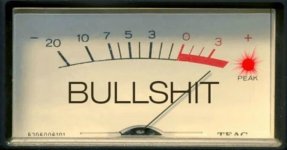Cooks like snake oil.
Attachments
Last edited:
Over TWO HUNDRED BUCKS for that thing. 😡
(Not the Presto)
Yea but you can burn in your cables 🙄
Please excuse my previous outburst. I hadn't noticed this model includes frequency modulation!! That changes everything, of course.
😡
😡
I had to try and not laugh when a friend of mine invited me over last week to see his set up. I never realised how much of an audiophile he was until i saw what he had.
I did not bother to ask too many questions, but first thing i noticed was "cable lifters" first time ive ever seen them, dunno what purpose they serve. He was only using 30W speakers and the cable was almost as heavy as no8 wire!
He also had placed these rocks made from a special mineral that I cant remember the name of, but he said it was to reduce RF noise in the room that his gear picks up.
To top it off when he saw my tube amp, he asked why i had a volume knob on it, as this will damage the signal, and my reply was, "well how are you supposed to adjust the volume?!" he said to use the preamp, and i showed him my preamp which had no volume knob, and then he tells me that its only a phono stage, even though its labelled as a preamp.
Im totally lost here, anyway, he has a fancy "preamp" for adjusting the volume and also has a phono stage feeding this, so really he is using two preamps on his system, which ive never seen before.
I did not bother to ask too many questions, but first thing i noticed was "cable lifters" first time ive ever seen them, dunno what purpose they serve. He was only using 30W speakers and the cable was almost as heavy as no8 wire!
He also had placed these rocks made from a special mineral that I cant remember the name of, but he said it was to reduce RF noise in the room that his gear picks up.
To top it off when he saw my tube amp, he asked why i had a volume knob on it, as this will damage the signal, and my reply was, "well how are you supposed to adjust the volume?!" he said to use the preamp, and i showed him my preamp which had no volume knob, and then he tells me that its only a phono stage, even though its labelled as a preamp.
Im totally lost here, anyway, he has a fancy "preamp" for adjusting the volume and also has a phono stage feeding this, so really he is using two preamps on his system, which ive never seen before.
I think the only proper response to this discovery is as follows:
"Oh no! Those are the wrong type of cable lifters for the type of music you listen to."
Then you can leave as your friend frantically Googles what type of cable lifters are best for different types of music.
"Oh no! Those are the wrong type of cable lifters for the type of music you listen to."
Then you can leave as your friend frantically Googles what type of cable lifters are best for different types of music.
Im totally lost here, anyway, he has a fancy "preamp" for adjusting the volume and also has a phono stage feeding this, so really he is using two preamps on his system, which ive never seen before.
A phono ' preamp ' only boosts the signal from a turntable cartridge , a ' pre- amp ' is used to adjust signal ( volume and or tone ) before being fed to a power amp .
An integrated amp contains both the pre and power in one box and on many the RIAA
( phono ) is also incorporated.
Hope that clarifies things , as for cable lifters ........... i can't comment as some words are prohibited on the forum 😀
Hope that clarifies things , as for cable lifters ........... i can't comment as some words are prohibited on the forum 😀
The one thing you could say is that they are the perfect compliment to a Bybee-loaded setup.
as for cable lifters ........... i can't comment as some words are prohibited on the forum 😀
Picture, thousand words and all that..
Attachments
No, I'm sure it's the colour that's most important. Of course, the gold coloured ones are probably the most expensive, too...
Note that some guys drifted for "dark side of the audio".I had to try and not laugh when a friend of mine invited me over last week to see his set up. I never realised how much of an audiophile he was until i saw what he had.
I did not bother to ask too many questions, but first thing i noticed was "cable lifters" first time ive ever seen them, dunno what purpose they serve. He was only using 30W speakers and the cable was almost as heavy as no8 wire!
He also had placed these rocks made from a special mineral that I cant remember the name of, but he said it was to reduce RF noise in the room that his gear picks up.
To top it off when he saw my tube amp, he asked why i had a volume knob on it, as this will damage the signal, and my reply was, "well how are you supposed to adjust the volume?!" he said to use the preamp, and i showed him my preamp which had no volume knob, and then he tells me that its only a phono stage, even though its labelled as a preamp.
Im totally lost here, anyway, he has a fancy "preamp" for adjusting the volume and also has a phono stage feeding this, so really he is using two preamps on his system, which ive never seen before.
Your friend talk about potentiometer and put a pre in series with the signal...
 😱
😱Outrageous contradictions, at least...
I also have "audiophile" friends and I know about listening to this claims...
The best thing I make in my system is got rid of preamps (except RIAA)
A phono ' preamp ' only boosts the signal from a turntable cartridge , a ' pre- amp ' is used to adjust signal ( volume and or tone ) before being fed to a power amp .
An integrated amp contains both the pre and power in one box and on many the RIAA
( phono ) is also incorporated.
Hope that clarifies things , as for cable lifters ........... i can't comment as some words are prohibited on the forum 😀
Yes ive since discovered that the "pre amp" is known as a line stage, and the phono stage is seperate! lol
Ive only ever heard of preamps before, but it seems my confusion is because they all used to be integrated.
This brings into question if i build an integrated amp, should i design it so the RIAA phono stage is powered off if the source is selected to say the CD player or other auxiliary input?
This way, it would extend the life of those tubes since its pointless leaving them running if you are not using the phono stage.
Where to buy this meter? Is it real peak or VU-type? And does it detect buybuys?Picture, thousand words and all that..
Last edited:
On the subject of Cable Lifters, I have a row of PVC Pipe hangers (Plastic J hook)
along the back of my desk to use as a cable try, cheap and effective.
Not snake oil, just better than having them lay all over the place
along the back of my desk to use as a cable try, cheap and effective.
Not snake oil, just better than having them lay all over the place
Where to buy this meter? Is it real peak or VU-type? And does it detect buybuys?
This meter is truly amazing, totally customizable and detects anything you want.
Readily available in any reputable photoshop.
On the subject of Cable Lifters, I have a row of PVC Pipe hangers (Plastic J hook)
along the back of my desk to use as a cable try, cheap and effective.
Not snake oil, just better than having them lay all over the place
Ahhh! But use the wrong plastic, and you end up with a lot of dielectric absorption! 😀
Jan
Note that some guys drifted for "dark side of the audio".
Your friend talk about potentiometer and put a pre in series with the signal...
😱
Outrageous contradictions, at least...
I also have "audiophile" friends and I know about listening to this claims...
The best thing I make in my system is got rid of preamps (except RIAA)
There's another possibility where the friend may be right. The amp may be "integrated" meaning it has inputs and input selection (if that's a feature...) and a volume control (perhaps also tone controls). In that case, the "preamp" without volume control may well be a phono stage - most line stage "preamps" include a volume control as it's generally better to attenuate the signal before the line stage amplification (to minimize noise from the pot).
Amps with volume controls tend to be designed as standalone units with sufficient amplification for most sources (other than phono and some tape signals, which require more amplification). In that case, the volume control is still attenuating the incoming signal from the source (for example a CD, cassette player, or phono stage) so it most likely does no more harm than the one in the friend's system. Most of my DIY amps are "integrated" in this way.
The friend is also "right" in that the volume control DOES degrade the sound (very slightly in the case of stepped attenuators). It does no matter where it happens. But of course, a system without a volume control... 😱
- Status
- Not open for further replies.
- Home
- Member Areas
- The Lounge
- Funniest snake oil theories

